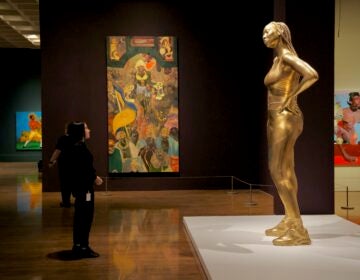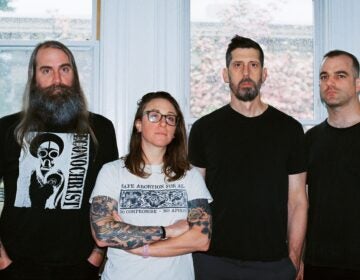New book shows how MF DOOM came to Philly and found a creative home among misfits
The biography “The Chronicles of DOOM” features a chapter of the elusive rapper’s life spent recording with the artists of Space 1026.
Listen 3:30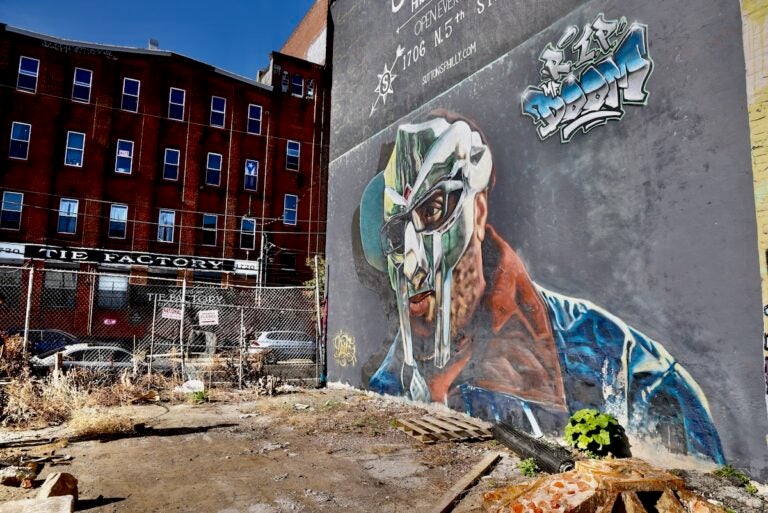
A mural depicting MF DOOM was painted on the side of a building near 5th Street and Cecil B. Moore Avenue shortly after his death in October 2020.(Emma Lee/WHYY)
From Philly and the Pa. suburbs to South Jersey and Delaware, what would you like WHYY News to cover? Let us know!
When the late rapper MF DOOM came to Philadelphia in 2001, he fell in with a group of eccentric artists who had carved out an odd space for themselves in Chinatown at 1026 Arch St.
Called Space 1026, it was where DOOM started to put together one of his celebrated albums “Vaudeville Villain” under the alias Viktor Vaughn.
“It’s a really futuristic album. I think only now people are getting that album,” said S.H. Fernando, Jr., aka SKIZ, author of the new DOOM biography “The Chronicles of DOOM.”
“I think initially when it first came out people were, like, ‘What the hell is this?’” he said.
DOOM, aka Daniel Dumile, was in an exceptionally fertile creative period at the time. Between 2000 and 2005, he released eight albums on eight independent labels under (at least) three pseudonyms.
Although sometimes considered “underground,” in part because he performed as a character based on a comic book villain wearing a metal mask, DOOM was a huge presence in the hip-hop world before he died in 2020 at age 49 due to complications from kidney disease medication.
A DOOM track even ended up on President Joe Biden’s inauguration playlist in 2021.
So how did a major musician wind up with a bunch of “weirdos” on Arch Street adjacent to a Chinatown bus parking lot?
“Here’s this legendary rap guy who had gone through his third incarnation of identities, and he’s friends with all these weird punk rock, hippie and bike messenger-styled graffiti-writing guys and girls,” said Cosmo Baker, a longtime Philadelphia DJ.
“Strange bedfellows, absolutely,” he said. “There’s something to be said about people who view themselves as outcasts, ‘rejects,’ but wearing that term as a badge of honor.”
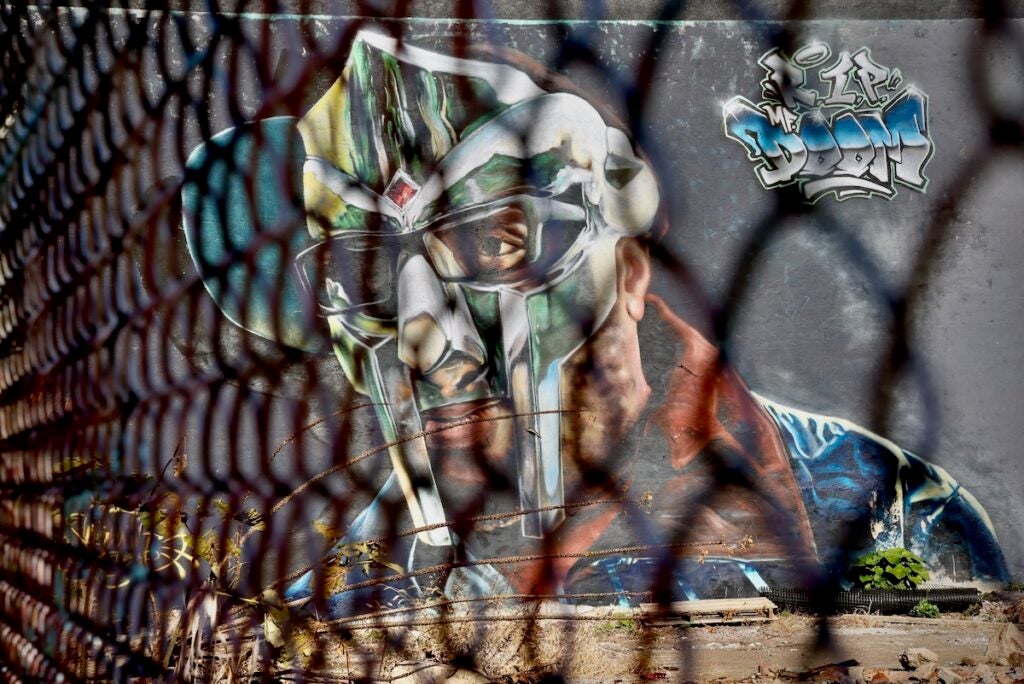
The unauthorized “The Chronicles of DOOM” is the first comprehensive telling of Dumile’s life, from his birth in London, childhood in Long Island, and his first forays into hip hop in the group KMD with his younger brother Subroc, who tragically died at 19 after getting hit by a car.
The death of his brother and his disdain for record labels drove Dumile to drop out of the world of hip hop, becoming “damn near homeless” in Manhattan.
He returned as an entirely new persona fueled by comic books and a general distrust of the music industry. As DOOM, Dumile donned a mask that was both protective and ferocious.
“He had his bout with fame early on when he was a teenager in high school and he didn’t enjoy it,” SKIZ said. “So he said, ‘If there is the next time I come back, I’m going to come back with the mask cover my face.’”
In 2001, DOOM came to Philadelphia to perform at Fluid, a nightclub off South Street where Baker was then running his weekly Remedy hip-hop night. Although it was a Monday, the club was sold out with hundreds of people.
When it came time to perform, Dumile opened a metal attache case he always carried with him and took out the infamous mask. Baker had never seen such a total personality transformation, before or since.
“After hours of spending time with him during this first trip to Philadelphia, and him being the kindest, sweetest, most gracious dude that you could imagine,” he said. “I have never witnessed in my life such an extraordinary metamorphosis in front of me, where he legitimately transformed from Daniel to the villain MF DOOM. His aura, his stance, his attitude, his affect: he became the villain.”
The performance that followed has become a storied part of hip-hop lore: after the show MF DOOM reportedly chased a group of hecklers into the alleyway behind Fluid and beat them, using his metal attaché case to knock one of them out.
The incident has been immortalized as “Monday Night at Fluid,” written as a “public service warning” by King Ghidra, another alias of Dumile.
During that time in Philadelphia, Dumile was staying with Maximillian Lawrence, a founding member of Space 1026 who was then supplementing his income as a short-order cook by wheat pasting concert promotional posters around the city. His connections with music labels dropped DOOM into his care.
Lawrence brought DOOM to 1026 Arch St. The artist collective was then in a semi-dilapidated building in a run-down part of town, outfitted with artist studios and a gallery space dominated by a skateboard half-pipe built in the middle.
“I think he was really entertained by the fact that we were a bunch of dirty people living with a halfpipe in a gallery,” he said. “There are all these punk rock elements and the vibe is a mixture of wheat paste and squat.”
Lawrence brought DOOM into his studio to wait for a radio interview to start, and DOOM noticed Lawrence’s recording gear. He asked if Lawrence made beats, and could he hear some?
The scrappy, do-it-yourself ethos of Space 1026 seemed to resonate with DOOM, whose intentionally sloppy beats and delivery ignored the glossy sheen of hip-hop production that was popular at the time.
“This was a time in the early 2000s when the sonic landscape of rap was really becoming shiny,” Baker said, referring to the production duo The Neptunes, a young Pharrell Williams and Chad Hugo.
“If you think about the classic Neptune sound, it’s very, very bright. It’s very, very tight. The drums have a certain rigidness to it,” he said.
DOOM was working up a different kind of sound that was so grimy it slurred. The first time Lawrence heard a DOOM track in 1999, “Rhymes Like Dimes” from the “Doomsday Operation” album, he thought he was drunk.
“You could smell it through the speakers,” he said. “His production was super sloppy. That’s what makes it good. He was able to find these sloppy moments and it worked perfectly with the way he raps.”
DOOM wasn’t drunk. He was finding a sound.
“It was all intentional,” Baker said. “It was nowhere near as syncopated as a lot of other machine gun-firing rappers, with pop-pop-pop-pop-pop-pop. It was way more relaxed with these pregnant pauses in the strangest places.”
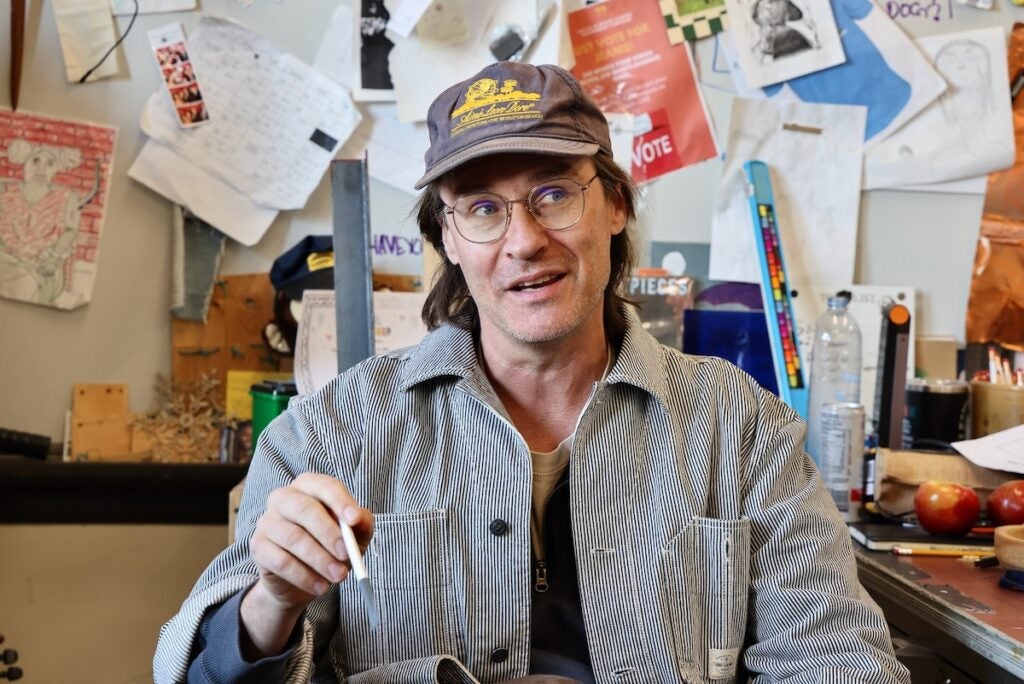
Lawrence knew he did not have the chops to make an entire album with DOOM. He brought in producers from the Sound Ink label in New York, who split their time between New York and Philadelphia to write and record the tracks on “Vaudeville Villain.”
Some vocals were laid down in the 1026 Arch St. building. Lawrence claims you can still hear beeping sounds from Chinatown buses as they back up in the adjacent parking lot.
“Oh yeah!” he said. “It’s all over the place. You can hear it.”
Lawrence got some writing credit on the album and is listed in the liner notes as “executive gardener.”
“A scrappy group of artists, the whole DIY mentality of trying to do it yourself, anti-corporate mentality, these are all very important things when it comes to Doom,” SKIZ said. “When he initially came down to Philly and to Space 1026, he found that he was respected by all these freaks. He was, like: ‘Hey, this is my spot.’”
Space 1026 is no longer at 1026 Arch St. It was forced to move out of the building and found a new home at 844 North Broad St., but has kept the name Space 1026. Now 27 years old, the collective is funded in part by its annual auction, happening Dec. 13.

Get daily updates from WHYY News!
WHYY is your source for fact-based, in-depth journalism and information. As a nonprofit organization, we rely on financial support from readers like you. Please give today.



